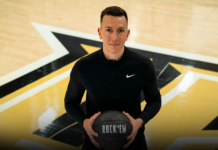The idea of invisibility is moving away from science fiction and closer to reality thanks to a a team of researchers at the University of Central Florida.
For years, scientists have known that artificial nanostructures, known as metamaterials, made from synthetic textiles can be used to to control the propagation of light. In other words, the artificial material bends light around an object, rendering it invisible to certain wavelengths.
The problem, however, has been that they could only fabricate the material in microscopic sizes.
Debashis Chanda, an assistant professor at UCF, has been working on the light-bending science for the last decade and new research depicted in the March edition of the journal Advanced Optical Materials explains how Chanda and fellow optical and nanotech experts were able to develop a larger swath of multilayer 3-D metamaterial operating in the visible spectral range.
The team accomplished this feat by using nanotransfer printing, which can potentially be engineered to modify surrounding refractive index needed for controlling propagation of light.
“Such large-area fabrication of metamaterials following a simple printing technique will enable realization of novel devices based on engineered optical responses at the nanoscale,” said Chanda..
By improving the technique, the team hopes to be able to create larger pieces of the material with engineered optical properties, which would make it practical to produce for real-life device applications. For example, the team could develop large-area metamaterial absorbers, which would enable fighter jets to remain invisible from detection systems.
While invisibility cloaks won’t be on shelves anytime soon, Chanda told the Orlando Business Journals he’s already received interest from local companies interested in funding more research and possibly commercializing it, including Lockheed Martin.
Chanda worked on the project with the following team: Li Gao, Youngmin Kim, Kazuki Shigeta, Steven Hartanto and John Rogers from the University of Illinois at Urbana-Champaign; Abraham Vasquez-Guardado and Daniel Franklin from UCF: Christopher J. Progler from Photronics Inc. and Gregory R. Bogartfrom the Sandia National Laboratories.






